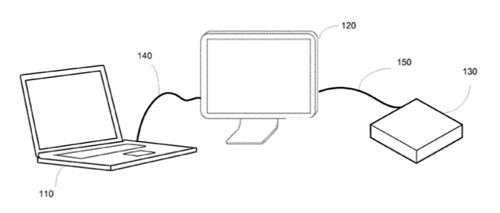An Apple patent (number 20120215950) for cross-over and bypass configurations for high-speed data transmission has appeared at the U.S. Patent & Trademark Office. It shows that Apple is working ways to improve networking techniques for transferring data among various electronic devices.
One method involves daisy-chaining devices together. That is, several devices may be connected to each other through a series of cables to form a chain of devices. In this physical configuration, data may be shared among multiple devices using a series of single-hop virtual tunnels.
Another method: a number of tunnels may be formed by a host device, each having a target device in the daisy chain. Each tunnel may originate at the host device and terminate at their target device. Each tunnel may bypass devices between the host device and the tunnel’s target device. These two techniques may also be combined. Another example may provide a method of simplifying the routing of high-speed data signals through a network topology.
Here’s Apple’s background on the invention: “Computing environments are becoming increasingly complex. One reason is that computing tasks are becoming more complicated. Another is that extremely high-quality, specialized computing devices are becoming popular.
“These ever increasingly complicated tasks have driven a recent evolutionary change to many people’s computer systems, specifically, the inclusion of multiple display screens. For example, an electronic engineer may use one display to show a schematic of a portion of an electronic device and another display to show a layout of that portion of the electronic device. Also, these complicated tasks have led to increases in the amount of data that needs to be stored. In particular, video applications may be capable of generating huge amounts of data. In response, external hard drives have become a popular way to store this data.
“The availability of specialized devices has also acted to increase many user’s computing environments. For example, laptop computers have become so powerful that for many, they are not only a portable computing device, but have taken over duties as a desktop computer as well. But often times, perhaps at work or at home, users may want a bigger screen than a laptop may provide. In such a case, a larger, external display may be used. Also, a laptop may have a limited storage capacity. This, and a desire to perform backup tasks, may prompt a user to add an external storage drive.
“To share data, these devices need to connect to each other, either through cables, wirelessly, or by using other means. When connecting these devices through these cables, it may be useful to be able to optimally utilize the bandwidth available at these connections. Thus, what is needed are circuits, methods, and apparatus that may improve networking techniques for transferring data among various electronic devices.”
Eric W. Anderson is the inventor.


